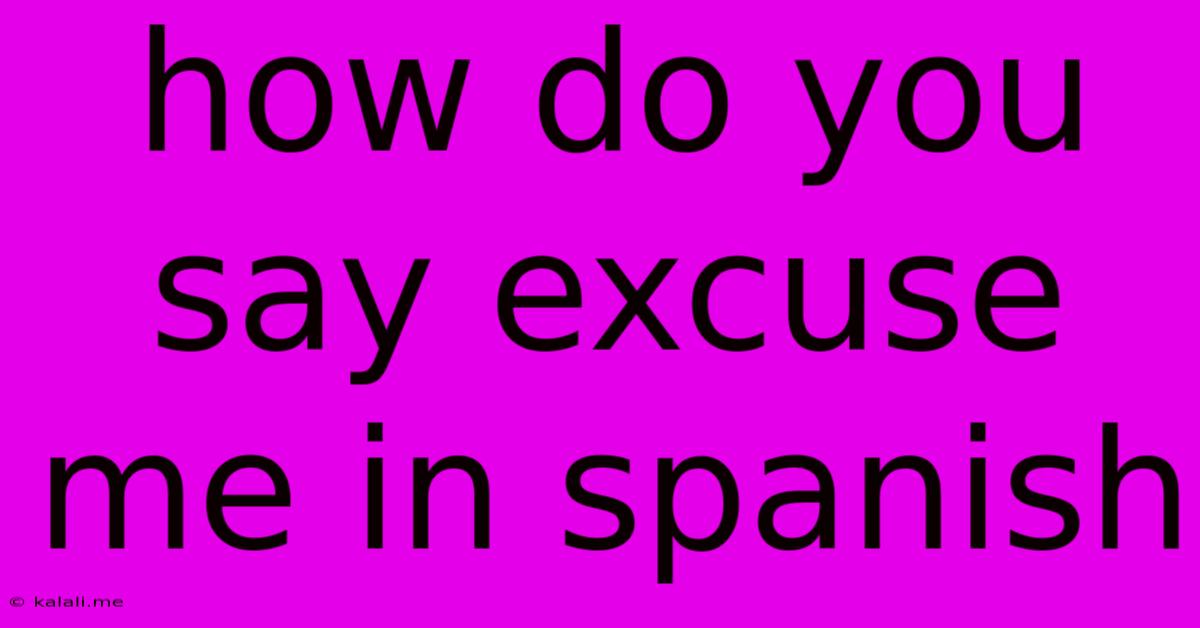How Do You Say Excuse Me In Spanish
Kalali
May 21, 2025 · 2 min read

Table of Contents
How Do You Say "Excuse Me" in Spanish? A Comprehensive Guide
Knowing how to say "excuse me" in Spanish is crucial for navigating any Spanish-speaking country. It's a polite phrase used in a variety of situations, and mastering its nuances can greatly enhance your interactions. This article explores the various ways to say "excuse me" in Spanish, depending on the context, and offers insights into proper usage.
Different Ways to Say "Excuse Me" in Spanish
The most common translation of "excuse me" in Spanish is "disculpe". However, the Spanish language, rich in its expressiveness, offers several alternatives, each with its own subtle connotations:
1. Disculpe (Formal and Informal)
-
Disculpe is the most versatile and widely accepted way to say "excuse me." It's appropriate in both formal and informal settings. You can use it to get someone's attention, apologize for a minor inconvenience, or politely interrupt a conversation. Think of it as the equivalent of a general-purpose "excuse me" in English.
- Example: Disculpe, ¿dónde está el baño? (Excuse me, where is the bathroom?)
2. Perdón (More for Apologies)
-
Perdón translates more directly to "pardon" or "sorry" in English. It's generally used when you've done something that requires an apology, like accidentally bumping into someone. While it can be used similarly to "disculpe," it carries a stronger connotation of apologizing for a specific action.
- Example: Perdón, no te vi. (Sorry, I didn't see you.)
3. Con permiso (For Getting Past Someone)
-
Con permiso literally means "with permission." This phrase is particularly suitable when you need to pass someone, perhaps in a crowded space. It's a polite way to ask for their indulgence as you move past.
- Example: Con permiso. (Excuse me – to get past someone)
4. Perdone (Formal Variant of Perdón)
-
Perdone is the formal version of "perdón." Similar in meaning, it emphasizes politeness and respect, making it suitable for formal situations or when addressing elders.
- Example: Perdone, señor, ¿podría ayudarme? (Excuse me, sir, could you help me?)
Choosing the Right Phrase
The best way to say "excuse me" in Spanish depends largely on the context:
- For getting someone's attention: Disculpe or Perdone are both suitable choices.
- For apologizing for a minor mishap: Perdón or Disculpe work well.
- For politely interrupting someone: Disculpe is the most appropriate option.
- For passing through a crowded area: Con permiso is the most natural choice.
Beyond the Basics: Improving Your Spanish Communication
Mastering these phrases is just the beginning of effective communication in Spanish. Learning additional polite phrases, practicing pronunciation, and immersing yourself in the language will further enhance your interactions and show respect for the culture. Remember, confidence and a genuine effort to communicate go a long way!
By understanding the subtle differences between these phrases, you can choose the most appropriate way to say "excuse me" in Spanish, ensuring clear and polite communication in any situation.
Latest Posts
Latest Posts
-
The Default Interactive Shell Is Now Zsh
May 21, 2025
-
When To Use Yours Faithfully Sincerely
May 21, 2025
-
Can Aerosols Be Put In Checked Baggage
May 21, 2025
-
Garage Door Opener Not Working With Remote
May 21, 2025
-
Do Yellow And Red Go Together
May 21, 2025
Related Post
Thank you for visiting our website which covers about How Do You Say Excuse Me In Spanish . We hope the information provided has been useful to you. Feel free to contact us if you have any questions or need further assistance. See you next time and don't miss to bookmark.